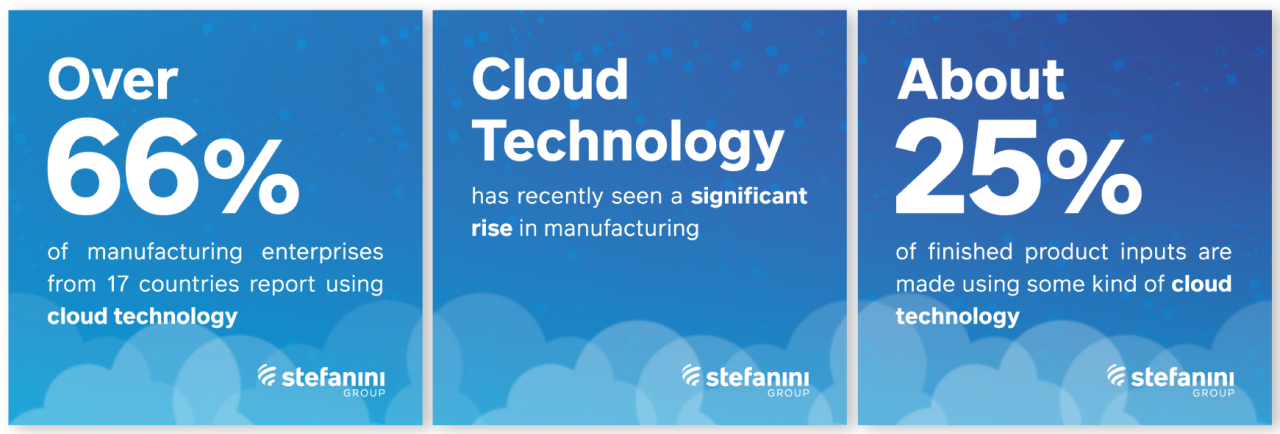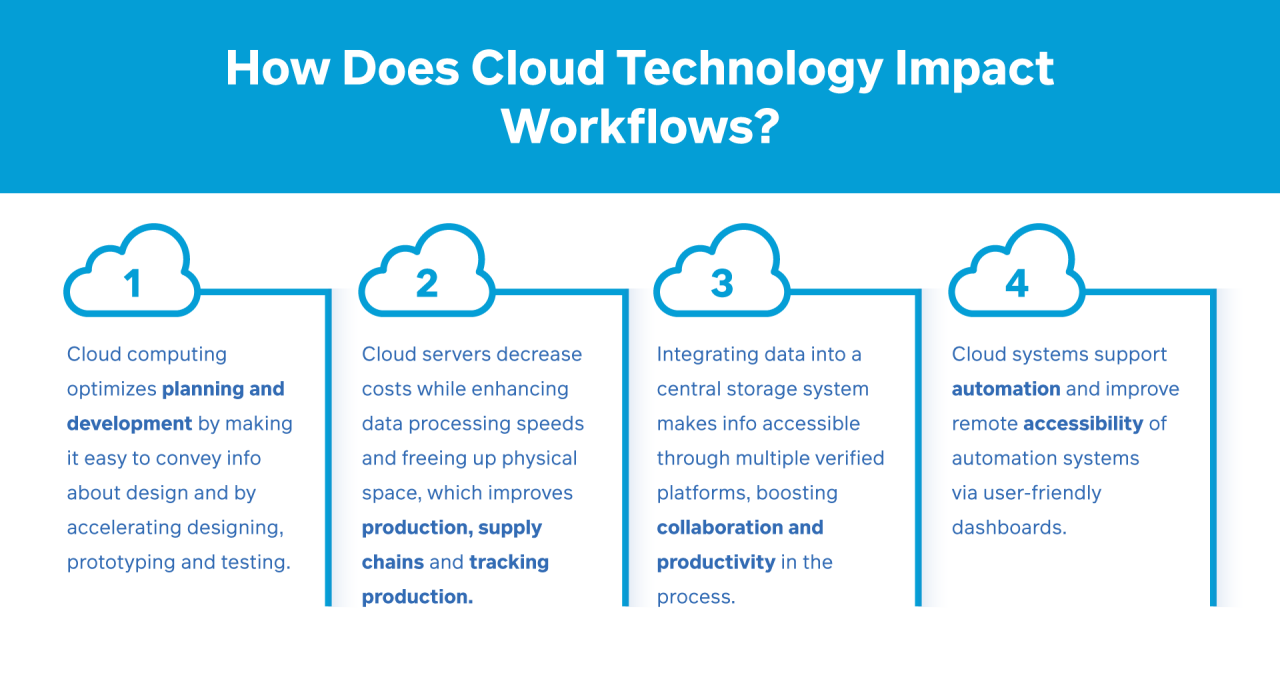The manufacturing industry today, while dealing with higher-than-ever demands, is also combatting high infrastructure costs. The importance of timely communications are at an all-time high and are vital for re-adjusting business operations to match market demands.
It is through cloud technology that manufacturers, plant floor employees, senior management and even logistics partners are elevating the technology standards of their firms and solving these issues.

Over 66% of manufacturing enterprises from 17 countries reported using cloud technology of some sort. Manufacturers must adapt to these reformations in the industry. And with this urgency created, the question remains… What is cloud technology really?
In this blog, we shall take a deep dive into the world of cloud solutions and how plant floors across the world are benefitting from them.
How is artificial intelligence improving cloud computing? Learn more here!
What is Cloud Technology and How Does It Simplify the Plant Floor?
Cloud technology is technology that uses internet connections to store information used in the various steps of the plant floor. The information is stored in what is known as the “cloud.” These internet servers allow for faster speeds, higher efficiency, and most importantly, lower costs.
In manufacturing, cloud technology has recently seen a significant rise, with about 25% of finished product inputs being made using some kind of cloud technology.
The cloud’s rise in the manufacturing business is a phenomenon that every company should be taking advantage of. Cloud computing trumps traditional communications simply by utilizing lighter IT infrastructure. Some of the ways in which cloud technology simplifies the plant floor are as follows:
- Scalability: Cloud computing’s scope is adjustable. Meaning, that if a business needs to grow, the technology can be upscaled accordingly. This saves newer businesses from spending more than they need to.
- Reliability: Cloud-based technology presents fewer problems than most of the software used on individual computers.
- Centralized management: The information stored over the cloud can be accessed through any verified device of the organization. This improves communication and management capabilities.
- Cutting down costs: Cloud technology solutions do not require in-house servers.
- Miscellaneous Marketplace advantages: Cloud solutions give companies a competitive edge over others. This is due to better productivity and communication that the technology provides.
Cloud solutions are available in the form of Software as a Service (SaaS), Infrastructure as a Service (IaaS), and Platform as a Service (PaaS).
How Does Cloud Technology Impact Workflows?

#1 Planning and Development Phases
Given that product planning and development is the base of all industrial production, efficient workflow becomes almost a necessity in this realm. Luckily, with cloud technology, we can achieve vivid results in almost all aspects of product development.
Cloud computing easens conveying information regarding design ideas, quantity measurements, material choices, storage information, etc. Setting this data up on cloud-based systems allows relevant authorities to take the necessary steps and precautions to develop their ideal batch.
When it comes to product development, traditional tools and verification processes consume significantly more time. Cloud technology is being used to accelerate and carry out this series of processes, which includes designing, prototyping, and testing. These complex designs and simulations are processed under CAD (Computer-Aided) softwares. CAD software utilises cloud technology for remote work and allows teams to work in unanimity.
Additionally, with cloud-hosted Computer-Aided Manufacturing (CAM) Software, companies are enabled to develop “least-cost prototypes” and kickstart safety tests.
#2 Production, Supply Chains, and Tracking Production
The production process is such that it requires constant monitoring and surveillance. A simple mishap can significantly decrease the quality of the batch. Due to this, plant floors are typically set up with complex monitoring equipment that can collect large amounts of data.
But on the flipside, these facilities require complex and heavy IT infrastructure to be installed in order to handle them. Companies are now unanimously shifting to cloud based servers to combat this issue. Cloud servers, along with significantly decreasing the costs, enhance data processing speeds and free up physical space, which in turn improves the efficiency of the machinery.
However, monitoring alone cannot produce a gold batch on the plant floor. The production process requires simpler and frequent decision-making systems on the production schedules. Cloud based ERP systems allow production teams to regulate available stocks with actual sales in mind, and make the necessary decisions.
ERP applications aid the customers’ requests in an interesting process too. It quotes price data for incoming and outgoing stocks. It further consolidates customer requests and orders, analyzes each of them by running them through a series of algorithms and gives an estimation of the demand at hand. These demand forecasts can be used to develop better plans for the production schedule and manage the resources to create a more continuous supply system.
#3 Collaborations and Productivity
Firms with a high number of employees often collaborate to enhance the workflow and flexibility of production operations. The teams, as a result, are in a constant exchange of crucial data and information. Integration of this data in a centralized storage system, one that is employed by cloud technology, making the information accessible through multiple verified platforms. This strengthens the collaborative efficiency of the organization at hand.
Cloud technology allows plant operators to keep accurate logs on equipment operating conditions. This gives maintenance technicians real-time access to logs and data gathered by condition-monitoring software platforms. These condition-monitoring sensors are maintained by computerized maintenance management systems and mobile maintenance software platforms.
In the pursuit of preventing isolated defects and upholding the quality of products, companies are investmenting in control equipment. This equipment is mostly cloud.based comparative analysis software. Investments like these help discard defective products and generate alteration alerts for production tools.
Cloud-based worksheets can also enable plant-floor employees to log in their working hours, maintenance summaries, and safety inputs.
#4 Automation and Remote Accessibility
Automation and intelligent systems are put in place to add a touch of perfection to the facilities operated by humans. This is done while keeping in mind that human-operated facilities are subject to error. This may be due to overlooking, fatigue, or due to the repetitive nature of the tasks at hand.
However, with automation systems installed, the room for error is significantly reduced, almost eliminating quality issues in production . Plant floors typically feature logic controllers, pneumatic and hydraulic systems, and robots that rely heavily on computer power. The high computing power and infrastructure needed for said automations can be satisfied with cloud technology. Cloud systems provide these features and improve the accessibility of automation systems via user-friendly dashboards.
With the quality of products optimized, only one thing could possibly go wrong on the plant floor – untimely equipment malfunctions.These equipment breakdowns and unfortunate halts can result in gigantic financial, material and equipment damage.
On the brighter side, Predictive Management (PdM) programs are being embraced by production firms to monitor the conditions of equipment during production. These further generate accurate maintenance reports which are employed in production-friendly schedules. Said PdM programs can often have high computing architecture needs. But cloud systems make these possible with cost-effective and timely maintenance efforts.
Conclusion
Cloud technology solutions are the best fit for collaborative manufacturing businesses. Their scalability, price-effectiveness and remote accessibility make them the technology of the future. The plant floor will be incomplete with cloud solutions in a few years from today. This is why education about the cloud is a necessity in the manufacturing business.
About the author: Bryan Christiansen is the founder and CEO of Limble CMMS. Limble is a modern, easy-to-use mobile CMMS software that takes the stress and chaos out of maintenance by helping managers organize, automate, and streamline their maintenance operations.



















